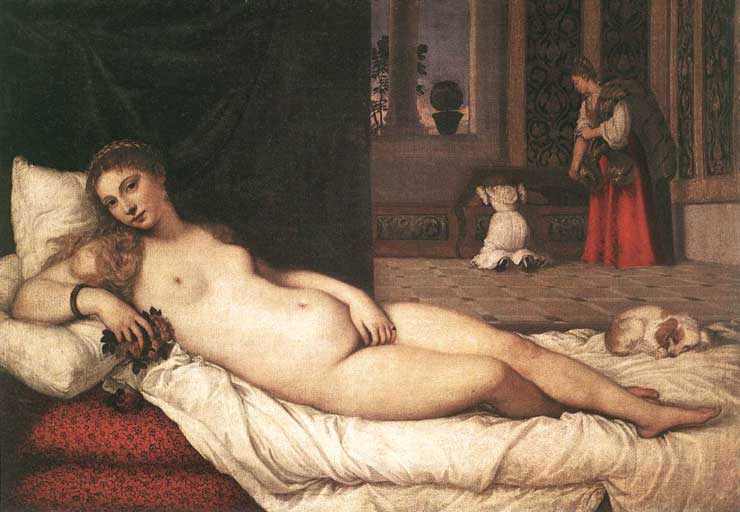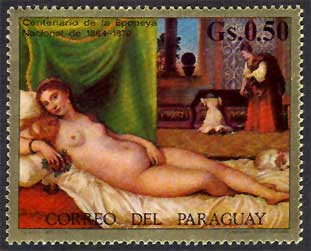|
|
 Venus of Urbino" by Tiziano Vecelli (Titian) (1538) The Venus of Urbino (1538) is an oil painting by Titian. It depicts a nude young woman, identified with the goddess Venus, reclining on a couch or bed in the sumptuous surroundings of a Renaissance palace. It hangs in the Galleria degli Uffizi in Florence. The pose is based on Giorgione's Sleeping Venus (c. 1510, Gemäldegalerie Alte Meister, Dresden), but Titian uses more sensuallity in comparison to Giorgione's sublime remoteness.
Giorgione's Sleeping Venus (c. 1510) Devoid as it is of any classical or allegorical trappings ('Venus' displays none of the attributes of the goddess she is supposed to represent), the painting is unapologetically erotic. The frankness of Venus's expression is often noted; she stares straight at the viewer, unconcerned with her nudity. In her right hand she holds a posy of flowers whilst her left covers her pubic area, provocatively placed in the centre of the composition. In the near background a dog, symbolising fidelity, is asleep. The painting was commissioned by Guidubaldo II della Rovere, the Duke of Urbino. It would originally have decorated a cassone, a chest traditionally given in Italy as a wedding present. The maids in the background are shown rummaging through a similar chest, apparently in search of the Venus's clothes. Curiously, given its overtly erotic content, the painting was intended as an instructive 'model' for Giulia Varano, the Duke's extremely young bride. In his 1880 travelogue A Tramp Abroad Mark Twain called the Venus of Urbino 'the foulest, the vilest, the obscenest picture the world possesses'. He proposed that 'it was painted for a bagnio and it was probably refused because it was a trifle too strong', adding humorously that 'in truth, it is a trifle too strong for any place but a public art gallery'.
Olympia by Édouard Manet Venus of Urbino inspired the later painting Olympia by Édouard Manet, in which the figure of Venus was replaced with a prostitute. The brightest scholar in the studio of Gian Bellini was a young man by the name of Giorgio, but they called him Giorgione, which being interpreted means George the Great. He was about the age of Titian, and the two became firm friends.
Venus of Urbino, Stamp References Berrson, Robert. Responding to Art (2nd ed.). Boston: McGraw Hill. ISBN 0-697-25819-X.
Links Titian's Venus of Urbino - critical review of the painting
Retrieved from "http://en.wikipedia.org "
|
|
||||||||||||||||


